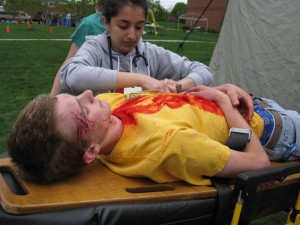Keeping Boston Strong: How Disaster Training at Osteopathic Medical School Helped Save Lives

The Bioterrorism and Disaster Response Program equips students at VCOM with critical skills through field exercises and more (photo courtesy of VCOM).
When Danielle Deines crossed the finish line of the Boston Marathon on April 15, she had no idea her unique medical training as Doctor of Osteopathic Medicine would make a real difference in the life-and-death events that would soon unfold.
A 2012 graduate of the Edward Via College of Osteopathic Medicine – Virginia Campus (VCOM), Dr. Deines immediately sprang into action after the explosions violently rocked the most prestigious race in the country. Triaging people in the medical tent to ensure they received the care they needed, she helped make room for victims on a moment’s notice:
“They asked all of the runners to move to the back of the tent,” Dr. Deines said. “Once there as the volunteer physicians headed to the explosion sites, I made an effort to get to my feet and informed the nurse near me that I wanted to help. I was asked to discharge runners who were able and interested in leaving to help make room for the victims who were starting to be brought in from the street. I cleared those wishing to leave and signed off on their discharge paperwork, then helped to get them out of an entrance that had been made in the side of the tent. We then moved the freed up cots to form triage areas. The back corner became the most severe triage area, nearest the entrance where the ambulances were arriving. I saw victims with traumatic amputations of the lower extremities, legs that had partially severed or had shrapnel embedded, and clothing and shoes literally blown off of victims’ bodies.”
Dr. Deines’ ability to help at the time of urgent need did not come coincidentally. Her education at VCOM equipped her — and all other graduates of the Blacksburg, Virginia school — with the critical life-saving skills that are needed when attacks or other emergencies strike.
The Bioterrorism and Disaster Response Program, a two-day, mandatory training curriculum for all second-year osteopathic students at VCOM, has immersed students in real-life disaster training, field exercises and specialized courses since its inception in 2003. This comprehensive approach gives participants expertise in areas including terrorist and major disaster response, hospital planning, behavioral risk factors, psychological response to trauma, and media relations.
Students who have completed the program now serve as lifelines, having the ability to respond to catastrophes locally, nationally and internationally – from Hurricane Katrina to the Virginia Tech shootings, tsunamis and tornado damage in Virginia.
Now more than ever, a working knowledge of disaster response issues is central to providing quality patient care.
“All medical students and practicing physicians need to be able to respond to natural and manmade disasters. With changing global weather patterns such as global warming and changing political climates, disasters are now a part of the framework,” said Dr. James Palmieri, Associate Professor and Dept. Chair at VCOM. “I always teach the students that no matter what kind of disaster takes place, both natural and manmade, it will always begin in someone’s neighborhood and the local medical community will be part of the initial response. In light of today’s instant communication, if and when you respond, the world will see you as the local expert. You had better know how to respond properly for both your benefit and that of your patients.”
How can VCOM’s leadership role in disaster response training be replicated by other medical training programs? In what ways can more medical schools develop and leverage their curricula to prepare students for disaster response?
Today, more than one in five medical students in the United States are training to be osteopathic physicians, who can pursue any specialty, prescribe drugs, perform surgeries and practice medicine anywhere in the U.S. Osteopathic physicians bring the additional benefits of osteopathic manipulative techniques to diagnose and treat patients, helping patients achieve a high level of wellness by focusing on health education, injury prevention, and disease prevention.
For students who are interested in going into osteopathic medicine, visit the American Association of Colleges of Osteopathic Medicine, www.AACOM.org; and VCOM at http://www.vcom.vt.edu/.
















